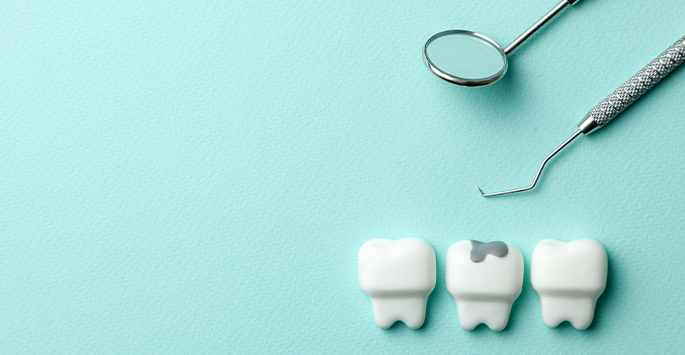BLOG
Which Dental Fillings Are Best for Tooth Decay?
Posted on: September 10, 2024

Advances in dental care and hygiene notwithstanding, tooth decay or cavity remains an issue for many Americans. Actually, 26% of adults in the U.S have untreated tooth decay. If not treated on time, tooth decay can lead to more severe dental health issues, including failing and abscessed teeth. This is why it’s vital to visit a Palo Alto dentist regularly so that they check for symptoms of tooth decay.
Dental fillings to treat tooth decay
If you have cavities, your dentist may advise you to have a dental filling done. A filling is a procedure that involves using some combination of materials to restore a tooth’s functional integrity. In other words, this dental procedure strengthens a damaged or decayed tooth by filling it with specific materials.
There are different types of dental filling. A tooth can be filled by composite, amalgam, gold, ceramic, and glass ionomer fillings. The right type of filling will depend on factors such as:
- Dentist’s recommendation
- The extent of the repair needed
- The location of the cavity
- Your budget/cost of the procedure
Let us explore in detail what each of the above fillings entails.
What type of dental filling is best?
Amalgam fillings
They are also referred to as silver fillings, despite the fact that they contain more metals than just silver. Usually, they are a mixture or amalgam of silver, tin alloy, and copper, as well as elemental mercury. Dentists have used amalgam fillings for decades. This is mainly because they continue to be the least costly filling type and also one of the most durable.
According to a 2016 study, the average age of an amalgam filling is around 15 years. Another 2008 study placed the survival rate of amalgam dental fillings offered by private practices anywhere from 7.1 to 44.7 years.
Composite filling
Composite fillings are made from a mixture of resin and acrylic that is carefully applied to the cavity while soft but later hardened by the LED light. It’s a popular choice since it can be color-matched to the shade of the patient’s existing teeth, making them almost indistinguishable. That said, composite fillings don’t last as long as Amalgam fillings. According to a 2014 study, these fillings can last around ten years.
Note: the material used to make composite filling is also used to fill in small gaps between teeth and repair chipped teeth.
Gold fillings
Gold fillings, as you may expect, are more expensive than composite or amalgam restorations. They are, however, more durable. According to the American Dental Association (ADA), gold fillings can last about 20 years.
Ceramic
Ceramic fillings have a natural look that resembles composite fillings. One main advantage of ceramic is its long lifespan. However, ceramic fillings are usually limited to large cavities as they can be difficult to fit well into small spaces without fragmenting. In terms of costs, ceramic is more expensive than composite.
Glass ionomer fillings
Glass ionomer fillings are made from a mixture of acrylic and fluoroaluminosilicate glass and are ideal for young ones whose teeth are still changing. Glass ionomer fillings release fluoride, which helps to prevent teeth from future decay. That said, they only last a few years, as they are considerably weaker than composite and more likely to wear or tear.
Steps involved in filling a tooth
Examination and treatment plan
Your Orange Park FL dentist will examine the level of cavity or decay by looking at your teeth. If your dentist believes that the cavity might be deeper, a tiny X-Ray might be conducted to examine that specific tooth. Also, a panoramic X-Ray might be required to check the prognoses of all teeth. Dental fillings are perfect for fractures and minor decay, but your dentist will advise you accordingly.
Removal of tooth cavity
In case the cavity is deep, your dentist may administer anesthesia to numb the area before they start getting rid of the decay. For the majority of cases, the treatment is performed on the surface and doesn’t require local anesthesia.
The damaged or decayed tooth is prepared using a drilling handpiece. The entire section is cleaned and decontaminated to eliminate lingering bacteria or debris.
Tooth filling and polishing
The filling material is carefully applied to fill the cavity. The finished tooth is polished and any excess material is trimmed off.
Caring for your teeth with fillings
To maintain your dental fillings, follow good oral hygiene practices such as:
- Brushing with a fluoride toothpaste
- Flossing at least two times per day
- Visiting your dentist bi-annually for cleanings
Contact your dentist immediately if:
- You feel a sharp edge
- Your teeth are exceedingly sensitive
- If you notice a missing piece of a filling
- If you see a crack in a filling,
Visit the best family dentist in Orange Park, FL for the best advice on fillings
Cavities, if not treated properly, can lead to tooth loss. Dental fillings exist to prevent worse damage from occurring. Your Orange Park, FL dentist is best positioned to advise you on the best filling type whenever you need a tooth restored. Schedule an appointment today!
At Blue Turtle Dental, most of our patients prefer the composite filling. While traditional fillings are made of metal mixtures, having a mouth full of silver or gold can leave patients dissatisfied with their appearance. White fillings protect the tooth against further decay while also maintaining a natural look.
Learn more about the dental fillings services near you we provide at Esthetics Implant Dentistry or schedule a consultation with one of our highly proficient dental team.
Article resources:
Information in this article has been gathered from multiple public health sources, including: